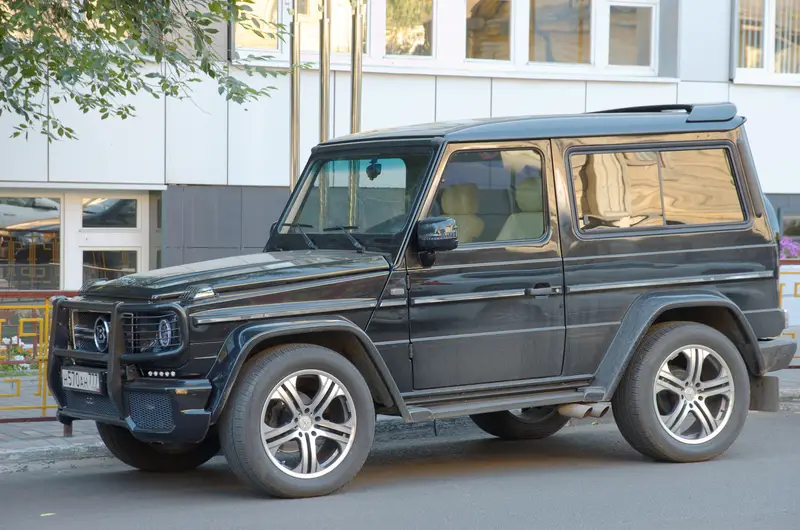
The Mercedes-Benz G-Class, usually known as the G-Wagon, has been around since 1979. Originally an off-road military vehicle, it was adapted to become a luxurious SUV that can handle whatever terrain it finds itself on.
Loved by the masses, the G-Wagon joins the ranks of truly iconic Mercedes. Equally as comfortable prowling off-road and coasting through the city, the G-Wagon has become the SUV of choice for drivers who want space, reliability, and cutting-edge performance.
But like all autos, the G-Wagon has suffered the occasional blip, with some years failing to meet its own rigorous standards.
Here are the 4 worst G-Wagon years to avoid.
1. 2019 G Wagon (W464)

The 2019 G Wagon ushered in a long list of changes, more than any of its predecessors since its launch in 1979. In theory, these changes should have made the G Wagon more suitable for modern use—but that wasn’t the case.
Part of the attraction of the G Wagon is its enormous off-road ability and its rugged design. Not only does the G Wagon look good, but it also packs a powerful punch when it comes to off-roading.
The 2019 model keeps its impressive axle clearance and total ground clearance, but with the new, independent front suspension, the overall impression is of a much more civilized auto. The beast that loves to get dirty has vanished to be replaced by a posh street crawler that offers smooth, sophisticated rides.
The redesign also changed the proportions of the G Wagon W464, making it longer and broader. This gave more room in the back seats, but drivers complained that it was difficult to get in and out. And bizarrely, despite the larger dimensions, the cargo area was smaller.
It’s not just that the 2019 relaunch changed the personality of the G Wagon. There are also plenty of genuine complaints about its reliability and performance.
The steering controls are over-sensitive, and combined with side-wind instability, off-road driving feels less intuitive and risky. The handling is slow and ponderous, making the whole drive feels sluggish, regardless of the terrain.
But possibly the most damning is the long list of reported issues collated by the National Highway Traffic Safety Administration (NHTSA).
This included:
- Serious electrical failures, including the electrical stability control
- Suspension problems
- Powertrain malfunction
- Service brakes issues
The issues with the 2019 W464 were so significant that the NHTSA issued 10 recalls due to recurrent problems with all of the above.
Owners have also reported minor electrical problems in the following components:
- Air-conditioning
- Heating
- Internal lights
- Wiring failure after relatively little mileage
Overall, despite the optimism around the relaunch of the 2019 Wagon, it’s widely agreed to have been a flop.
Reasons To Avoid
- Multiple major electrical failures leading to NHTSA recalls
- Widespread minor electrical failures
- New front suspension changes the driving experience
- Loss of authentic style
2. 2017 G Wagon

If the issues with the 2019 G Wagon seemed bad, then the 2017 model will be even more shocking. It’s generally agreed that the 2017 G Wagon is the worst year of manufacture.
The twin-turbo V8 engine loads up on power—but power is only a good thing if you can control it. Sadly the steering on the 2017 G Wagon is horrifically bad, only beaten to the bottom by its poor handling.
Off-road credentials are at the very core of the G Wagon’s appeal, but in 2017, the ill-thought-out exhaust placement made this problematic.
Although 2017 wasn’t subjected to the substandard 2019 redesign, the interior suffered from similar problems with space in the front, but additionally had little room for passengers in the rear either.
Poor fuel economy means that even if you can face sliding behind the wheel, you’ll be pouring dollars into the gas tank just to keep it on the road.
A litany of complaints dogged the 2017 G Wagon with a long list that included:
- Automatic braking malfunctions
- Defective ABS and EPS system
- Errors with the traction control system
- Failure of the front and rear sensors
- Navigation failure
- Faulty rear camera
- System module failures
Once again, the NHTSA had to intervene with the 2017 model. They recorded issues with electrical control stability, back over prevention, and forward collision avoidance.
As a result of the reported problems and the severity of the malfunction, the NHTSA issued four recalls for the 2017 G Wagon.
Although 2017 was the last year for the traditional G-Wagon design before the unpopular relaunch, the multiple problems with performance and failing systems mean this is one to skip.
Reasons To Avoid
- Multiple failures leading to NHTSA recalls
- Errors with braking, traction, collision avoidance, and stability
- Difficult to handle
- Poor fuel economy
3. 2015 G Wagon

Going a little further back to 2015 will reveal another poor year for the G Wagons. The more recent models fare worse than the older years in terms of reported problems, performance, and overall quality.
A pair of V8 engines provide the power, but drivers won’t find a choice of transmission. The seven-speed automatic is the only option, which is disappointing for the luxury end of the market. If you want to know more about how automatic and manual gearboxes work, you can check out my previous article on gearboxes.
Acceleration is fast, but the wind noise is particularly bad in this year’s Wagon. Wind noise tends to be an issue for many of the G Wagons, but drivers report the 2015 auto as having excessive wind and tire noise.
The steering is excellent for off-roading, but on normal terrain, the sluggishness in returning to the center after turning makes it difficult to handle. The tall and narrow dimensions of the G Wagon also make each turn feel rather precarious.
Like many of the G Wagons, the interior leaves a lot to be desired, with decent headroom but very poor legroom in both the front and back. However, the 2015 model also features plasticky cheap interior fittings, most notably the cupholders.
The door handles were also another small part that appears to have been manufactured poorly, with multiple occurrences of the handles getting stuck or failing to open.
Mechanically, a faulty cylinder head causing excessive leaking was reported as a common problem.
Other issues which have regularly been seen in the 2015 Wagon include problems with the following:
- Exhaust manifold
- Valve spring retainers
- Head gasket
Similarly to other years, the electrical systems were highlighted as a regular weakness. Engine failure has also been identified as a risk for the 2015 G Wagon once it reaches 100k miles (161,000 kilometers).
The cost of repairing the engine is estimated at anywhere between $1,500 to $5,000, so it’s not a fault that drivers should ignore.
In comparison to 2017 and 2019, the 2015 G Wagon looks like a dream. However, widespread trivial problems coupled with a handful of more serious concerns make this year another dud.
Reasons To Avoid
- Faults with the electrical system
- Engine failure
- Leaks caused by the cylinder head
- Flimsy door handles prone to breaking
4. 2016 G Wagon

Having just run through the many problems with the 2015 G Wagon, the big question is, would the following year fare any better?
Sadly not.
The issues with the 2016 G Wagon are remarkably similar to its predecessor, with most of the complaints left unaddressed.
Starting with the interior, the same problems are evident with the dimensions and comfort of the seating and overall layout. Cheap, flimsy cupholders are a minor but legitimate grumble, an inexpensive component that should be far superior on a luxury Mercedes.
The seven-speed automatic gearbox is once again the only transmission available, with the performance hampered by poor handling and awkward steering.
Wind and tire noise hamper the auto, but the 2016 Wagon was also troubled by cracking noises coming from the sunroof area. This is caused by connection problems between the hose and the motor, creating an audible noise.
The list of faults continues with airbag issues. Warning lights for the passenger airbag service at less than 1,000 miles (1,600 kilometers) and the airbag warning light were reported as continually illuminating. This seems to be a common fault experienced by many.
Braking system problems were one of the most frequently reported issues from 2015 to 2020, and this was evident with the 2016 G Wagon. Brake pad failure, brake rotor failure, and excessive wear were all noted with comparatively few miles on the clock.
Reasons To Avoid
- Braking system faults
- Electrical errors
- Connection problems with the sunroof
Final Thoughts
There’s no denying the fact that to a certain demographic, the G Wagon has an everlasting appeal. But an impressive off-road ability and sturdy design can’t compensate for manufacturing faults and poor performance in general.
Not all the years were created to the same high Mercedes-Benz standard, so if you want to avoid purchasing a money pit, it’s really important to do your research before buying.
When it comes to the G Wagon, older models sometimes mean better quality but always be sure of exactly what you’re buying.
